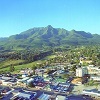Update
GEORGE NEWS - The PSHB beetle (Polyphagous Shothole Borer) is a relatively new pest to South Africa, but already it has sown a path of destruction in Sandton. Now it is almost certain that the insect and its fungus partner have arrived in George.
Different species of trees including keurboom, planes, oaks and maples are dying in various parts of town, including the Garden Route Botanical Garden, Van Riebeeck Park in Heatherlands, Camphersdrift and Loerie Park. They were examined by an expert who flew in to investigate possible infestation in George and Knysna.
Pretoria University Professor Wilhelm de Beer of the Ambrosia Beetle Working Group said, "The symptoms that I detected on various trees strongly indicate that PSHB beetle and its Fusarium fungal symbiont have been at work."
De Beer, an associate professor with the Forestry and Agricultural Biotechnology Institute (Fabi), said it would nonetheless take two to three weeks to complete DNA tests to confirm with 100% certainty that the aforementioned beetle and its host fungus are the culprits.
"Ideally, more research is necessary to find the most effective method to halt their destructive path. There are similar beetles and fungi and we have to be sure about the diagnosis.
"This species of beetle (also known as Euwallacea fornicatus) acclimatises and adapts its life cycle in various climatic regions. In order to control them, we have to understand when their flight season starts and ends as this would enable us to react in the most cost-effective way possible."
Axing
The axing and burning of the infected trees have been placed on hold for now, while the George Municipality seeks a suitable quarantined site for disposing of the sick trees. The ovens of local sawmills were mentioned as a possibility.
Nelson Mandela University lecturer Braam du Preez said that until a site has not been identified for disposing of the diseased trees, it is better not to move them for fear of aiding the spread of the beetle.
Interim measures
The municipality will issue a press release in this regard following the outcome of the DNA testing. In the meantime, people can report the occurrence of symptoms to parks@george.gov.za
Trees that are susceptible
De Beer said the beetle attacks many tree species, but breeds only on a few species.
"In South Africa, we know that they target oak trees, Chinese maples and Japanese maples, on which they increase their numbers. When they infect these trees it is best to axe and burn the branches and treat the stump, as the beetle continues to proliferate. Currently, chemical control is the only solution for trees of high value but it is expensive, difficult to apply and treatment has to be repeated every season."
In the meantime, our avocado farmers fear the worst. The beetle-fungus complex is known to be a major problem in Israel and California.
Read a previous article | Beetle Threat: Public asked to help
'We bring you the latest George, Garden Route news'
















